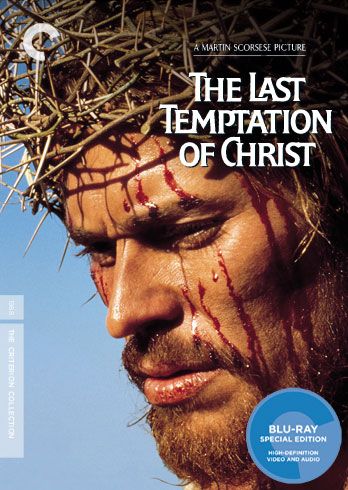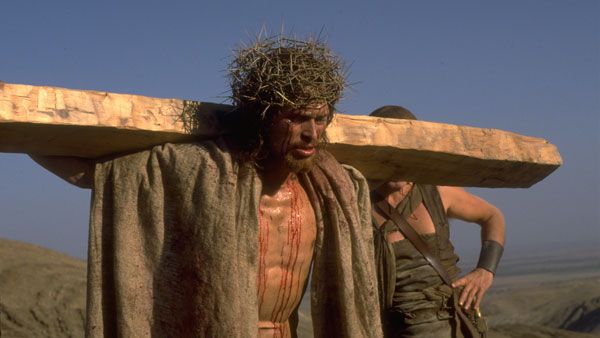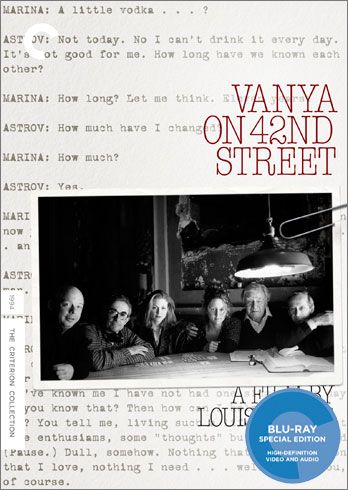The Martin Scorsese who put out The Last Temptation of Christ is not the Martin Scorsese we know today. He had yet to make Goodfellas, and though Raging Bull netted Robert De Niro an Oscar, Scorsese spent much of the 1980’s in the wilderness, making niche films which were considered disappointments, only to secure financing through directing a for-hire hit movie (The Color of Money). Christ was most notable for the controversy it engendered, as it was protested by a number of religious groups, which kept it out of most big chain theaters. Vanya of 42nd Street is a project that transcends its set-up, and acts as a follow-up to Louis Malle’s My Dinner with Andre. It reunited Andre Gregory and Wallace Shawn with a cast (that includes Julianne Moore) that performed Anton Chekhov’s Uncle Vanya on the fly for years. Both have come out from Criterion on Blu-ray, and our reviews of both follow after the jump.
Scorsese was adapting the Nikos Kazantzakis novel, which was and is considered blasphemous. Willem Dafoe stars as Jesus, who is haunted by the voices in his head. He starts the film making crosses, only for his mother (Verna Bloom) and Judas (Harvey Keitel) to yell at him for it, with Judas assigned to kill him. Judas decides to give Jesus some time as he sees something in him. Jesus goes to meet Mary Magdalene (Barbara Hershey), who offers her bed but he passes. Eventually, he begins listening to the voice of God and starts on that path - first by saving Mary from a stoning by noting something about those without sin. He gathers disciples, and the film sings when it finds new ways to reinterpret (cinematically) many of the most important moments in Jesus’s life. Then comes the crucifixion - and the film’s most controversial section - when Jesus is presented with an alternate life.
Often films feel like therapy sessions, and here Scorsese is wrestling with his faith and trying to understand who his (possibly former) lord and savior is. For Scorsese and for Kazantzakis it was about understanding Jesus as a man, and not just a savior. And to do so it must offend some – though the film is only rarely critical of Christian followers, mostly it’s a meditation on what it would mean to be Christ. Scorsese is on fire cinematically for most of the film especially when he tries to reinterpret the most famous passages of the bible, like when he’s presenting Jesus at the money changers, or protecting Mary from a stoning. You can see what he wants to believe.
But this is also the film of someone who is wrestling with their faith, and doing so in a public way. The film seems to ask “how can I make sense of these stories? What’s Christ’s motivation?” as it were. It’s a beautifully told tale, with some interesting casting (Kietel doesn’t hide his accent, while players include director Irvin Kershner and musician John Lurie) that never faulters – it’s a complete vision. The power comes from the viewer, and how they digest the material.
Criterion’s Blu-ray offers an upgrade in picture quality - the film is widescreen (1.85:1) and in sound as the film is now presented in 5.1 DHS-HD master audio. The transfer is a major improvement over the older DVD version, though much of its supplements come from the company’s laserdisc. The film comes with a thoughtful commentary from Scorsese, Dafoe, and writers Jay Cocks and Paul Schrader. They cover some of the controversy, Scorsese’s impetus for making the film, and much of how it was staged and thought of. The rest of the supplements kick off with a still gallery for costume designs, and then a second still gallery for publicity stills and paintings that helped give Scorsese visual stimulation. “On Location in Morocco” (16 min.) is taken from Scorsese’s home movies of the shoot, where he talks to the camera and shows what they were shooting. It’s very charming, though the quality is terrible. Finally the disc comes with a section on Peter Gabriel’s music. There’s an introduction to why Gabriel did the score, an interview with Gabriel (done for the laserdisc release, 12 min.), and a photo gallery showing some of the instruments used in the score.
Vanya on 42nd Street succeeds on two levels. On one level it is a fine staging of the original play. On another it showcases that great performances and great art is transcendent of location or dress – if we are engaged in a story and its characters, than we accept it, period. The film begins with the players gathering for the production that Andre Gregory has staged for a handful of audience members, and the play begins without introduction. Dr. Astrov (Larry Pine) has come to see hypochondriac Professor Serebryakov (George Gaynes) as Vanya (Wallace Shawn) and he socialize. Vanya is contemptuous of the professor, his brother-in-law, who married a pretty woman named Yelena (Julianne Moore) after his first wife died and lives in luxury in town. Vanya’s sister was the professor’s first wife, and Vanya now takes care of the family estate. The professor also has a daughter from the first marriage named Sonya (Brooke Smith).
It turns out that the doctor has a crush on Yelena, and Sonia has a crush on the doctor. But neither of the wanted are receptive. And when the professor decides to change how the family’s estate is run, he does so with no regards to the rest of his family.
The staging was done as something of a lark by Gregory, who started the production in 1989 with this cast (though with Ruth Nelson - who passed away long before filming started - instead of Phoebe Brand as the old maid Marina). They rehearsed the David Mamet-interpreted version of the play for a period, and then started showing it to friends in groups of twenty or thirty. When Gregory told Louis Malle about it, they staged it for the cameras for two weeks and then stopped entirely. But Malle records it perfectly, showcasing the intimate nature of the production, but also the power of great material. The film is engaging partly because it’s a magic trick. You forget that you’re watching people in normal dress on stage and become engaged in the material. And though one might quibble with some of the casting, you’re watching great performers find their way into classic material through alternative means. Which – in that way – makes it a great double feature with Last Temptation of Christ.
The Criterion Collection presents the film in widescreen (1.66:1) and in 2.0 uncompressed stereo. The film was originally shot on super 16mm, and this transfer is excellent. Extras are limited to the film’s theatrical trailer and “Like Life: The Making of Vanya on 42nd Street” (36 min.) which gets Andre Gregory, Julianne Moore, Wallace Shawn, Brooke Smith, Lynn Cohen, Larry Pine and George Gaynes to talk about the making of their show and of the movie.




